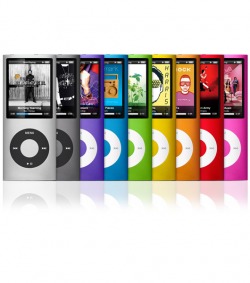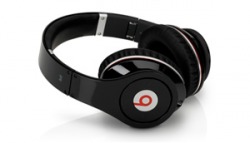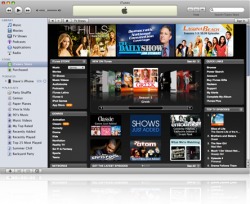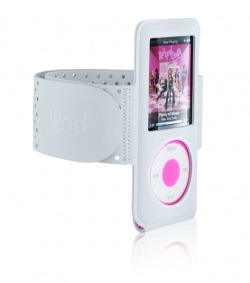iProducts

iPod is the brand of portable media players designed and marketed by Apple Inc. and launched on October 23, 2001. The product line-up includes the hard drive-based iPod Classic, the touchscreen iPod Touch, the video-capable iPod Nano, and the compact iPod Shuffle. The iPhone can function as an iPod but is generally treated as a separate product. Former iPod models include the iPod Mini and the spin-off iPod Photo (since reintegrated into the main iPod Classic line). iPod Classic models store media on an internal hard drive, while all other models use flash memory to enable their smaller size (the discontinued Mini used a Microdrive miniature hard drive). As with many other digital music players, iPods, can also serve as external data storage devices. Storage capacity varies by model.

Apple's iTunes software can be used to transfer music to the devices from computers using certain versions of Apple Macintosh and Microsoft Windows operating systems.[2] For users who choose not to use Apple's software or whose computers cannot run iTunes software, several open source alternatives to iTunes are also available.[3] iTunes and its alternatives may also transfer photos, videos, games, contact information, e-mail settings, Web bookmarks, and calendars to iPod models supporting those features. As of September 2008[update], more than 173,000,000 iPods had been sold worldwide, making it the best-selling digital audio player series in history.

The iPod line came from Apple's "digital hub" category,[5] when the company began creating software for the growing market of personal digital devices. Digital cameras, camcorders and organizers had well-established mainstream markets, but the company found existing digital music players "big and clunky or small and useless" with user interfaces that were "unbelievably awful,"[5] so Apple decided to develop its own. As ordered by CEO Steve Jobs, Apple's hardware engineering chief Jon Rubinstein assembled a team of engineers to design the iPod line, including hardware engineers Tony Fadell and Michael Dhuey,[6] and design engineer Jonathan Ive.[5] The product was developed in less than one year and unveiled on 23 October 2001. Jobs announced it as a Mac-compatible product with a 5 GB hard drive that put "1,000 songs in your pocket."[7]
Apple did not develop the iPod software entirely in-house, instead using PortalPlayer's reference platform based on 2 ARM cores. The platform had rudimentary software running on a commercial microkernel embedded operating system. PortalPlayer had previously been working on an IBM-branded MP3 player with Bluetooth headphones.[5] Apple contracted another company, Pixo, to help design and implement the user interface under the direct supervision of Steve Jobs.[5] As development progressed, Apple continued to refine the software's look and feel. Starting with the iPod Mini, the Chicago font was replaced with Espy Sans. Later iPods switched fonts again to Podium Sans—a font similar to Apple's corporate font, Myriad. iPods with color displays then adopted some Mac OS X themes like Aqua progress bars, and brushed metal meant to evoke a combination lock. In 2007, Apple modified the iPod interface again with the introduction of the sixth-generation iPod Classic and third-generation iPod Nano by changing the font to Helvetica and, in most cases, splitting the screen in half by displaying the menus on the left and album artwork, photos, or videos on the right (whichever was appropriate for the selected item).

The iTunes Store is an online media store run by Apple and accessed via iTunes. It was introduced on 29 April 2003 and it sells individual songs, with typical prices being US$0.99, or $1.29 AU$1.69 (inc. GST), NZ$1.79 (inc. GST), €0.99 (inc. VAT), or £0.79 (inc. VAT) per song. Since no other portable player supports the DRM used, only iPods can play protected content from the iTunes Store. The store became the market leader soon after its launch[12] and Apple announced the sale of videos through the store on 12 October 2005. Full-length movies became available on 12 September 2006.[13]
Purchased audio files use the AAC format with added encryption. The encryption is based on the FairPlay DRM system. Up to five authorized computers and an unlimited number of iPods can play the files. Burning the files onto an audio CD, then re-compressing can create music files without the DRM, although this results in reduced quality. The DRM can also be removed using third-party software. However, in a deal with Apple, EMI began selling DRM-free, higher-quality songs on the iTunes Stores, in a category called "iTunes Plus." While individual songs were made available at a cost of US$1.29, 30¢ more than the cost of a regular DRM song, entire albums were available for the same price, US$9.99, as DRM encoded albums. On 17 October 2007, Apple lowered the cost of individual iTunes Plus songs to US$0.99 per song, the same as DRM encoded tracks. On January 6, 2009, Apple announced that DRM has been removed from 80% of the music catalog, and that it will be removed from all music by April, 2009.
iPods cannot play music files from competing music stores that use rival-DRM technologies like Microsoft's protected WMA or RealNetworks' Helix DRM. Example stores include Napster and MSN Music. RealNetworks claims that Apple is creating problems for itself[14] by using FairPlay to lock users into using the iTunes Store. Steve Jobs has stated that Apple makes little profit from song sales, although Apple uses the store to promote iPod sales.[15] However, iPods can also play music files from online stores that do not use DRM, such as eMusic or Amie Street.
Universal Music Group decided not to renew their contract with the iTunes Music Store on 3 July 2007. Universal will now supply iTunes in an 'at will' capacity.[16]
Apple debuted the iTunes Wi-Fi Music Store on 5 September 2007, in its Media Event entitled "The Beat Goes On..." This service allows users to access the Music Store from either an iPhone or an iPod Touch and download songs directly to the device that can be synced to the user's iTunes Library.
